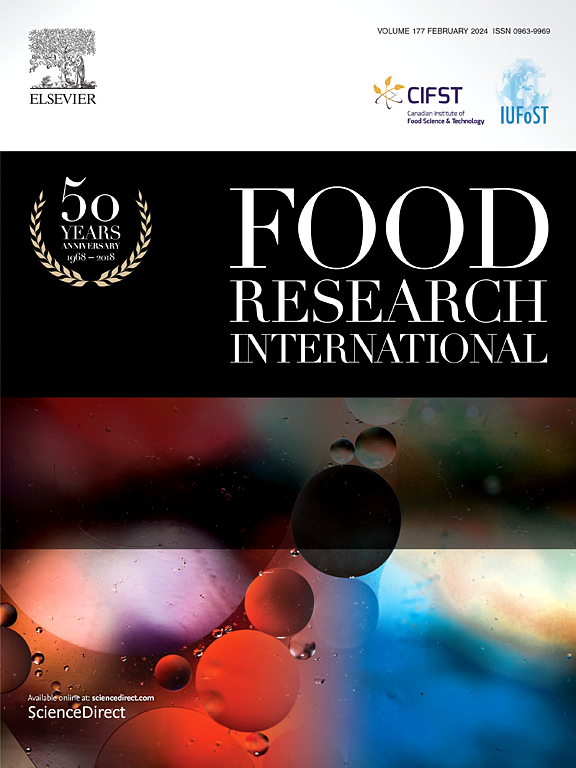利用GC-IMS和高通量16S rDNA测序研究盐浓度对发酵贝膏挥发性风味特征和微生物动力学的影响
IF 7
1区 农林科学
Q1 FOOD SCIENCE & TECHNOLOGY
引用次数: 0
摘要
本研究以蛤贝为原料,研究了不同盐浓度和发酵时间对蛤贝膏理化指标、微生物群落变化和挥发性风味成分的影响。通过GC-IMS对挥发性风味物质进行分析,共鉴定出77种挥发性风味物质,其中醛类化合物所占比例最大。采用高通量16S rDNA测序技术,对贝膏样品中优势菌群的组成进行解码。在门水平上,贝膏的关键微生物群落包括变形菌门、疣菌门和放线菌门;在属水平上,psychryobacter成为优势属。此外,本研究还分析了优势微生物群落与挥发性成分的相关性。通过VIP值分析发现,前20个优势菌种与风味成分之间存在显著的相关性。值得注意的是,psychryobacter与11种挥发性风味成分呈显著正相关,这些成分共同构成了自然发酵贝膏的特征风味。本研究提出的发酵工艺为低价值贝类资源的增值利用提供了新的途径。本文章由计算机程序翻译,如有差异,请以英文原文为准。

Elucidating the impact of salt concentration on volatile flavor profiles and microbial dynamics in fermented cockle paste using GC-IMS and high-throughput 16S rDNA sequencing
In the present study, cockles were utilized as the raw material to investigate how different salt concentrations and fermentation periods influence the physicochemical indices, microbial community shifts, and volatile flavor components of cockle paste. Through the analysis of volatile flavor substances via GC-IMS, a total of 77 volatile flavor compounds were identified, among which aldehydes accounted for the largest proportion. High-throughput 16S rDNA sequencing was applied to decode the composition of dominant microbiota in the cockle paste samples. At the phylum level, the key microbial communities in cockle paste included Proteobacteria, Verrucomicrobiota, and Actinobacteriota; at the genus level, Psychrilyobacter became the dominant genus. Moreover, this study analyzed the correlations between dominant microbial communities and volatile components. By means of VIP value analysis, it was found that there was a significant correlation between the top 20 dominant microbial species and flavor components. Notably, Psychrilyobacter showed a positive correlation with 11 volatile flavor components, and these components together formed the characteristic flavor of naturally fermented cockle paste. The fermentation process proposed in this study offers a new method for the value-added utilization of low-value shellfish resources.
求助全文
通过发布文献求助,成功后即可免费获取论文全文。
去求助
来源期刊

Food Research International
工程技术-食品科技
CiteScore
12.50
自引率
7.40%
发文量
1183
审稿时长
79 days
期刊介绍:
Food Research International serves as a rapid dissemination platform for significant and impactful research in food science, technology, engineering, and nutrition. The journal focuses on publishing novel, high-quality, and high-impact review papers, original research papers, and letters to the editors across various disciplines in the science and technology of food. Additionally, it follows a policy of publishing special issues on topical and emergent subjects in food research or related areas. Selected, peer-reviewed papers from scientific meetings, workshops, and conferences on the science, technology, and engineering of foods are also featured in special issues.
 求助内容:
求助内容: 应助结果提醒方式:
应助结果提醒方式:


